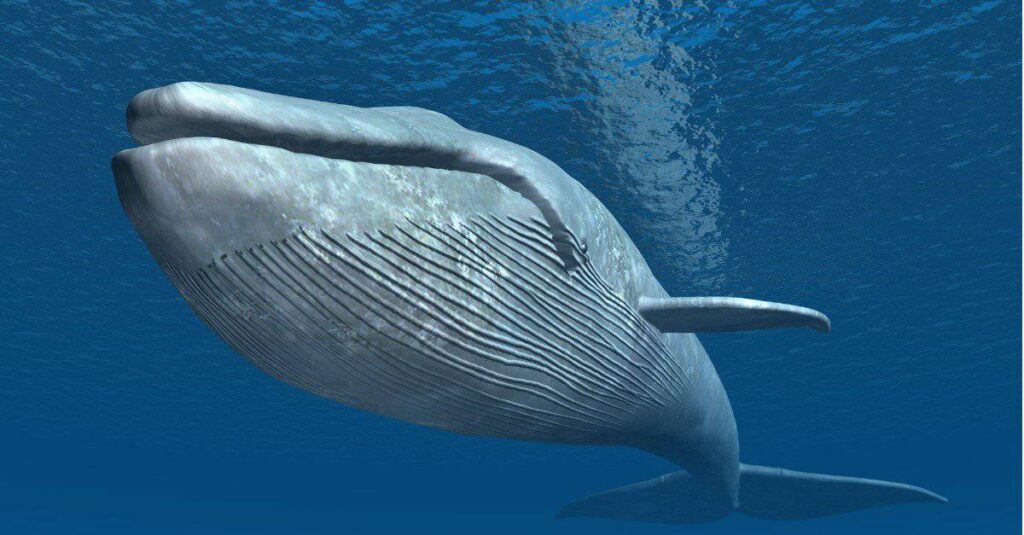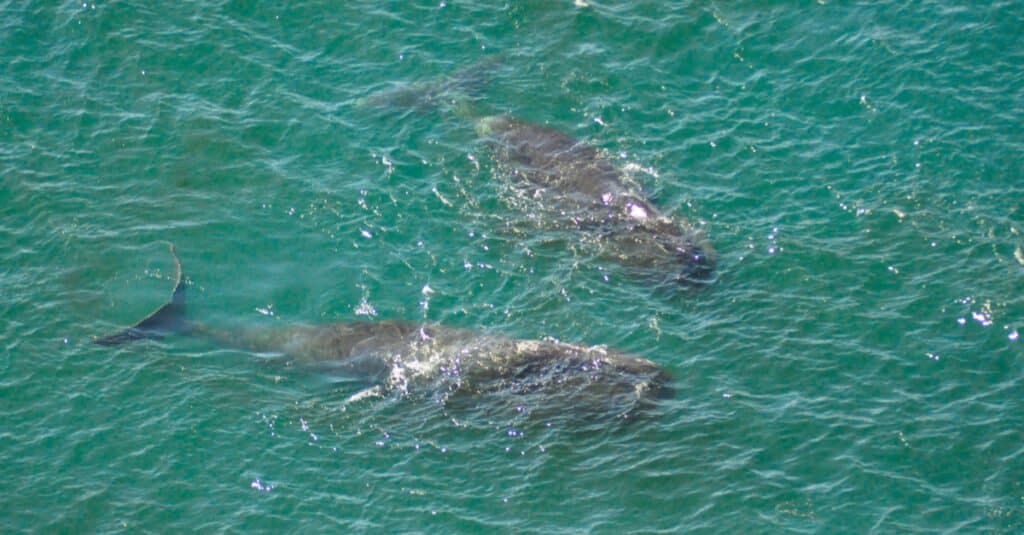Bowhead and blue whales are two of the largest mammals on earth, each weighing over 100 tons and measuring more than 50 feet long. And while the Bowhead whale population is currently around 50,000, only about 25,000 blue whales now live in our oceans after an estimated population of 350,000 just 200 years ago. As a result, the International Union for Conservation of Nature (IUCN) placed them on the endangered list in 2022. This listing prohibits anyone from hunting, capturing, or injuring these beautiful creatures.
Let’s dive into what separates bowhead whales vs. blue whales!
Bowhead Whale vs. Blue Whale: Comparison

| Bowhead Whale | Blue Whale | |
| Scientific Name | Balaena Mysticetus | Balaenoptera Musculus |
| Length | 45 – 60 feet | 72 feet to over 100 feet |
| Weight | 120,000 pounds | 286,000 – 330,000 pounds |
| Teeth | Baleen | Baleen |
| Diet | Krill | Krill |
| Lifespan | Up to 268 years | 80 – 90 years |
| Gestation | 13 – 14 months | 10 – 12 months |
| Population | 50,000 | 25,000 |
| Predators | Humans and Killer Whales | Humans and Killer Whales |
| Vocalization | <1000 Hz | 8 – 25 Hz |
The Key Differences Between Bowhead Whales and Blue Whales

Bowhead whales can weigh more than 100,000 pounds.
©bekirevren/Shutterstock.com
The key difference between bowhead whales and blue whales is that blue whales are larger while bowhead whales can live significantly longer. Other differences include appearance, their behaviors, and locations they’re found.
The two whales also have similarities. They’re both extremely large baleen whales that survive on a diet mostly composed of krill. Let’s look at more details of traits that separate these two massive whales.
Bowhead Whales vs. Blue Whales: Size
Bowhead whales are smaller than the Blue whale weighing in at 120,000 pounds and 45 to 65 feet long. However, the Blue whales‘ statistics are awe-inspiring, growing to between 286,000 and 330,000 pounds. That’s 50 times heavier than a fully grown male African bull elephant. Incredibly, the largest blue whale ever recorded weighed 418,878 pounds. That makes it the largest ever recorded animal on planet earth!

Blue whales are the largest animal ever to roam the earth.
©iStock.com/MR1805
Bowhead Whales vs. Blue Whales: Behavior
Bowhead whales get their name from their sizeable triangular skull that they use to break through the thick ice when they come up for air. They communicate with each other by means of hundreds of different types of songs. They are also able to leap entirely out of the water. They are not social animals and swim alone or in small pods. They can stay underwater for up to an hour at depths of 500 feet.
The Blue whale also communicates by singing a series of wails, whines, and other beautiful sounds. They are generally solitary but also swim in pairs, sometimes gathering in small and large groups of up to 50. They can dive to depths of 1,000 feet for about 30 minutes. Blue whales migrate between their summer and winter feeding grounds.
Bowhead Whale vs. Blue Whale: Where Are They Found?
Bowhead whales spend most of their time in the cold and arctic regions and inhabit the Bering, Chukchi, and Beaufort seas. Likewise, you will find these magnificent creatures swimming in the Hudson Bay and Foxe Basin, the Baffin Bay and the Davis Strait, the Sea of Okhotsk, and in the waters of eastern Greenland and Spitsbergen to east Siberia.
The Blue whale prefers warmer waters and lives in practically all oceans and seas except the Arctic.
Bowhead Whales vs. Blue Whales: Diet
Bowhead whales feed on zooplankton called krill, which are shrimp-like and less than one inch long. They feed on krill by swimming directly into their groups with an open mouth. Bowhead whales naturally filter the water back out through overlapping baleen plates as it fills their mouths. The Bowhead whale has the most enormous head of all the whales, which makes up about one-third of its body length, and the most extended baleen plates that grow up to 10 feet long.
Blue whales have much the same diet feeding mainly on krill, of which a fully grown whale needs to consume over 1,000 pounds daily. They perform a maneuver called lunge feeding, where they swim at the krill at high speed as they open their mouths. When their mouths are full, they squeeze all the water back out through their baleen plates and swallow the remaining krill.
Bowhead Whales vs. Blue Whales: Reproduction

©Vladimir Chebanov/Shutterstock.com
Bowhead whales start reproduction from ten to 15 years old. The breeding season is from March to August and the gestation period is 13 to 14 months, and the female will produce a calf every 3 to 4 years. A newborn calf is 13 to 15 feet long, weighs 1000 pounds, and can swim within 30 minutes. The calves weigh 2200 pounds in the first year and grow to 26 feet within the first year.
The Blue whales start reproduction from eight to ten years old, and mating begins from spring to winter. The gestation period is 10 to 12 months, and the calf weighs 2,000 to 3,000 pounds at birth and is 20 to 23 feet long. The calves are weaned after seven to eight months and can weigh an enormous 37,500 pounds in this short period.
A calf needs to drink a massive amount of milk to keep growing at a healthy rate, and the female whale needs to produce 240 to 710 pounds of milk per day. The calves can feed from the female whale underwater. To prevent water from getting into the calf’s mouth, the mother squirts the milk into its mouth as the calf wraps its tongue around the teat to prevent any water from mixing with the milk.
Bowhead Whales vs. Blue Whales: Bite Force
Bowhead and blue whales do not have teeth and do not rely on bite force for feeding or protection. They have baleen instead of teeth and use these to squeeze out the water when feeding on krill.
Bowhead Whale vs. Blue Whale: Predators

Orcas are considered an apex predator.
©slowmotiongli/Shutterstock.com
Bowhead and Blue whales have only one natural predator, the orca, or the killer whale. Orcas hunt whales in groups and are more successful in pursuing the calves as the adults defend themselves by slapping them with their tails.
The Bowhead whale used to be hunted extensively for its thick layer of blubber, the densest of all the whales. In addition, it swims slowly and floats after it has been killed, making it an ideal candidate for whaling. Unfortunately, due to its fat and meat popularity, commercial whalers at a whaling settlement in Spitsbergen killed an estimated 50,000 whales, starting in 1619. Likewise, whalers killed an estimated 18,600 Bowhead whales in the Bering Strait between 1848 and 1914.
The photo featured at the top of this post is ©
Thank you for reading! Have some feedback for us? Contact the AZ Animals editorial team.






